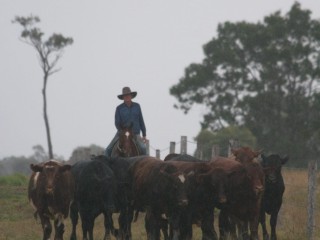 The first cold snap of the season in the south and the continuation of dry weather in the north could have significant implications for cattle turn-off and quality in coming months, according to livestock agents.
The first cold snap of the season in the south and the continuation of dry weather in the north could have significant implications for cattle turn-off and quality in coming months, according to livestock agents.
Colder winter temperatures returned to southern Australian this week, combined with opening rainfalls totalling 5-25mm across large parts of south eastern South Australia, Victoria and southern NSW.
Elders southern livestock manager Scott Altschwager said that despite this week’s colder conditions, the approach to winter so far had been relatively mild, and there had been little indication of feed in any areas being decimated by frost.
Mr Altschwager said most southern producers had their best bank of feed heading into winter for years, which would give them valuable control over their marketing decisions in the months to come.
“We have got a good body of feed going into winter, and there will certainly be no pressure selling because of the feed that is around the place,” he said.
“What will happen now is because of the slight downturn in the prices being received, people will pick their mark and most of them will maximise weights through the winter and look to market their cattle in early Spring.
“We are in the situation where producers can pretty much control supply to a certain degree, if the job comes off a bit they will hold back, and if it rises then they will sell a few.”
Mr Altschwager said that after the recent price falls, which had seen the Eastern States Young Cattle Indicator fall by 10% since March 28 to 387 points, he believed the market had now found a new level.
In northern Australia, after months of protracted wet conditions, the ground is finally drying out enough for mustering and branding to kick off in earnest, roughly two months later than normal.
Landmark’s northern region livestock manager, Brendan Wade, said restockers had been able to absorb the increased supplies so far.
“We’re starting to see the flow of cattle now and the store buyers are still handling them,” Mr Wade said.
“There are still people who want to buy cattle. In Northern NSW it is pretty dry but the store market is still responding fairly favourably, with the market at Walcha on Wednesday pretty strong for the special sale there.”
Another key question in the north surrounds the cattle market’s capacity to handle the heavier northern cattle that are no longer suitable for the Indonesian trade because of the market’s 350kg weight limits, imposed in June 2010.
After at least two wet summers, many northern stations have the seasons to return to their traditional market this year of growing out heavy, finished bullocks for the Jap Ox trade.
With the high A$ making Australian beef less competitive in Japan compared to US beef, the market’s ability to handle the additional supply of heavy cattle this year could be a telling factor.
“There could be some issues with those heavier cattle that are restricted from the live export trade,” Mr Wade said.
“Obviously the dollar has had more of an impact than we thought, processors were able to manage parity, and probably factored parity in, but now it is up there at US$1.07-US$1.08, which puts it in a different perspective.”
Prices for prime cattle gained 2-4c/kg at the benchmark Roma prime cattle sale yesterday, adding to indications that the market was stabilising.
